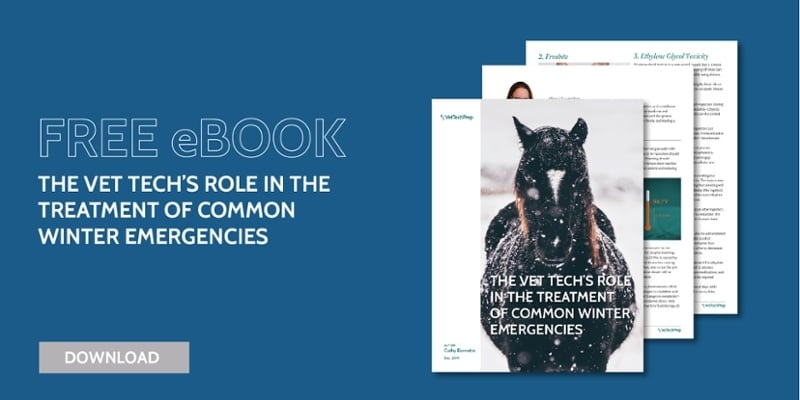.jpg?width=708&name=20191124_social%20media-37%20(1).jpg)
The Scenario: You’re working a quiet day shift at a small animal general practice. One of your coworkers comments that it is a slow day, prompting you to joke that they just jinxed the afternoon. Sure enough, the phone rings a few minutes later! It’s Mrs. Smith, a longtime client.
Mrs. Smith tells the receptionist that she saw her cat, Rudy, chewing some tinsel from the Christmas Tree a few days ago, but didn’t think much of it at the time.
Now she has noticed that Rudy is vomiting and doesn’t seem to be feeling well. The receptionist asks you what she should tell Mrs. Smith, and you tell her to have Mrs. Smith bring Rudy in right away.
Triage: When Mrs. Smith and Rudy arrive, they are placed in an exam room. Within minutes, you enter the room to triage Rudy for the veterinarian. Rudy is quiet, alert, and responsive, with a temperature of 102.4°F. You notice that his mucous membranes are a little bit tacky and his capillary refill time is 2 seconds. As you speak with Mrs. Smith, she reiterates that she saw Rudy with tinsel in his mouth a few days ago but didn’t think much of it at the time. Yesterday, however, Rudy vomited undigested food soon after eating his breakfast. He then continued to vomit throughout the afternoon. Now Rudy is lethargic, refusing to eat, and has vomited bile a couple of times today. You tell Mrs. Smith that you are very concerned about Rudy and will have the vet in to see her shortly.
Physical Exam: You return to the room with Dr. Adams, who confirms the history with Mrs. Smith and then begins her physical exam. On examination, she notices that Rudy is dehydrated and painful upon palpation of his abdomen. Dr. Adams also observes that Rudy is salivating more than usual. She advises Mrs. Smith that she’s concerned that the tinsel Rudy may have eaten could be causing problems, although it’s certainly possible that there is something else going on. Dr. Adams recommends bloodwork and abdominal radiographs to get to the bottom of what’s causing Rudy’s issues.
Treatment Plan: You prepare a written treatment plan for Mrs. Smith, including the diagnostics that Dr. Adams has recommended. The treatment plan includes a CBC, serum biochemistry panel, and abdominal radiographs. You review the treatment plan with Mrs. Smith, who authorizes all of the recommended testing and agrees to leave Rudy at the hospital for diagnostics.
Laboratory Tests: Rudy’s CBC shows mild polycythemia (packed cell volume = 60%). His white blood cell and platelet counts are normal. On the serum biochemistry profile, Rudy has an increase in plasma protein (TP = 9.3 mg/dL) with no other significant abnormalities. Dr. Adams, upon reviewing the bloodwork, notes that the increase in red blood cells and plasma proteins are both consistent with dehydration.
Abdominal Radiographs: You and a veterinary assistant obtain three-view radiographs of Rudy’s abdomen. Upon looking at these radiographs, you feel like you see something abnormal. Sure enough, Dr. Adams comes over and points out that Rudy has plicated (bunched) intestines and visible fluid in the stomach. The presence of fluid in the stomach of a cat that hasn’t been eating suggests impaired GI motility, while the plicated intestines suggest a linear foreign body as the likely source of the obstruction.
Client Communication: Dr. Adams prepares a treatment plan for surgery. Then she calls Mrs. Smith, describes the laboratory and radiographic findings, and explains that Rudy needs surgery to look for tinsel that may be retained within his intestines. Dr. Adams discusses the possible risks of the procedure, reviews the treatment plan with Mrs. Smith, and gets permission to go ahead with surgery.
Anesthesia and Surgical Prep: An intravenous catheter is placed and Rudy is premedicated with dexdomitor, ketamine, and butorphanol. A dose of a broad-spectrum injectable antibiotic is also administered, in preparation for entering the intestine and creating potential contamination. Once Rudy is relaxed, his ventral abdomen is shaved and anesthesia is induced with IV propofol. An endotracheal tube is placed and Rudy is connected to the anesthesia circuit for the administration of oxygen and isoflurane. You perform a thorough surgical scrub of Rudy’s ventral abdomen.
Exploratory Laparotomy: Dr. Adams creates a ventral midline incision and enters the abdomen. She then runs Rudy’s GI tract through her gloved hands, looking for abnormalities. In doing so, she discovers several areas of clumped, inflamed intestines. When she opens the intestine at each of these sites, she finds long strands of metallic tinsel within the intestine and removes them. Each enterotomy site is carefully closed with suture and leak-tested. Fortunately, in Rudy’s case, none of the intestine appears to be damaged to the extent of requiring resection; all of the intestine is viable. Rudy’s abdomen is closed routinely.
Post-surgical Care: After surgery, Dr. Adams calls Mrs. Smith while you transfer Rudy to the clinic’s recovery area. Rudy’s IV fluids will be continued for the next several days, to correct dehydration and provide fluid support as he regains his appetite. Rudy will also be treated with injectable pain medication. Rudy will be started on very small meals of a bland diet later in the evening, with the size of his meals gradually increased in the coming days.
Discussion
Diagnosis of a linear foreign body is often relatively straightforward, based on abdominal radiographs. In some cases, however, radiographic diagnosis may be challenging. In these patients, barium studies or abdominal ultrasound may be needed to make a diagnosis before proceeding to surgery.
Once discovered, a linear foreign body should be removed as soon as possible. If a linear foreign body has been in place for some time, it can exert a “sawing” effect on the intestines and lead to intestinal perforation. Pets with intestinal perforation have a guarded prognosis.
The greatest risk associated with enterotomy is dehiscence of the intestinal incision(s). A dehiscence rate of approximately 7-16% has been reported.(1) If dehiscence occurs, mortality may be high. Signs of dehiscence include fever, abdominal pain, and leukocytosis on post-op CBC monitoring.
In general, feeding is resumed approximately 12 hours after an enterotomy. Some veterinarians, however, advocate feeding as early as 4 hours post-op while others recommend waiting a full 24 hours post-op. Early feeding has the advantage of rapidly restoring GI motility, while allowing a long period of time for the intestines to heal may decrease the risk of incision leakage. Therefore, the timing of feeding post-op is an individual judgement call for each veterinarian.
Antibiotics are not routinely given after the removal of a gastrointestinal foreign body, because they could mask signs of dehiscence or underlying infection. Again, however, this is up to the discretion of the individual veterinarian.
References
- Allen DA, Smeak DD, Schertel ER. Prevalence of small intestinal dehiscence and associated clinical factors: a retrospective study of 121 dogs. J Am Anim Hosp Assoc 1992;28: 70-76.




